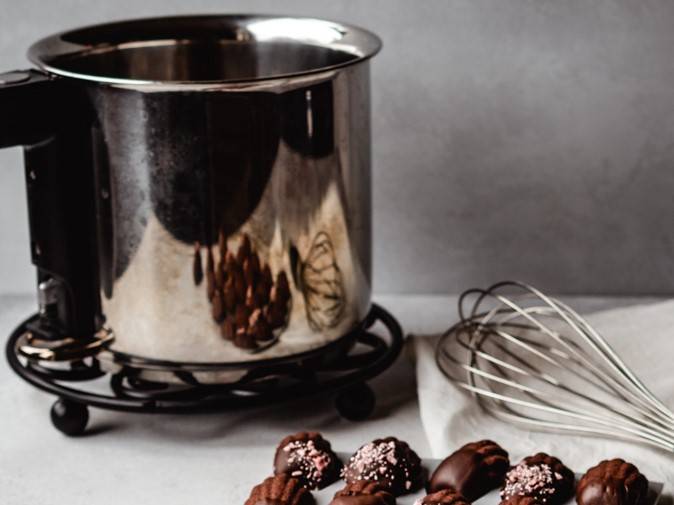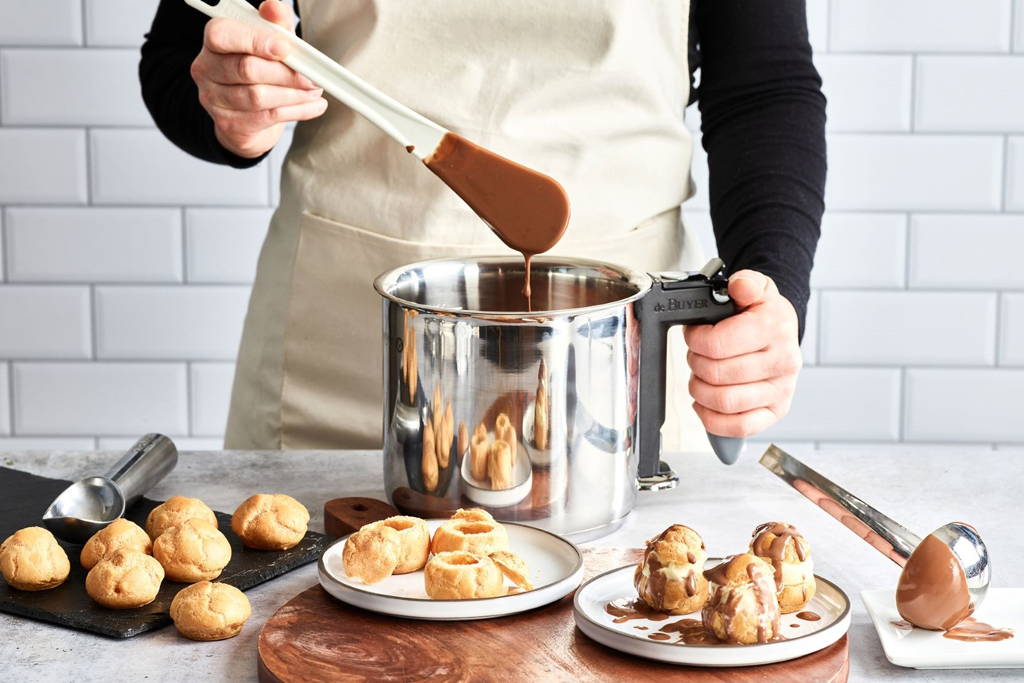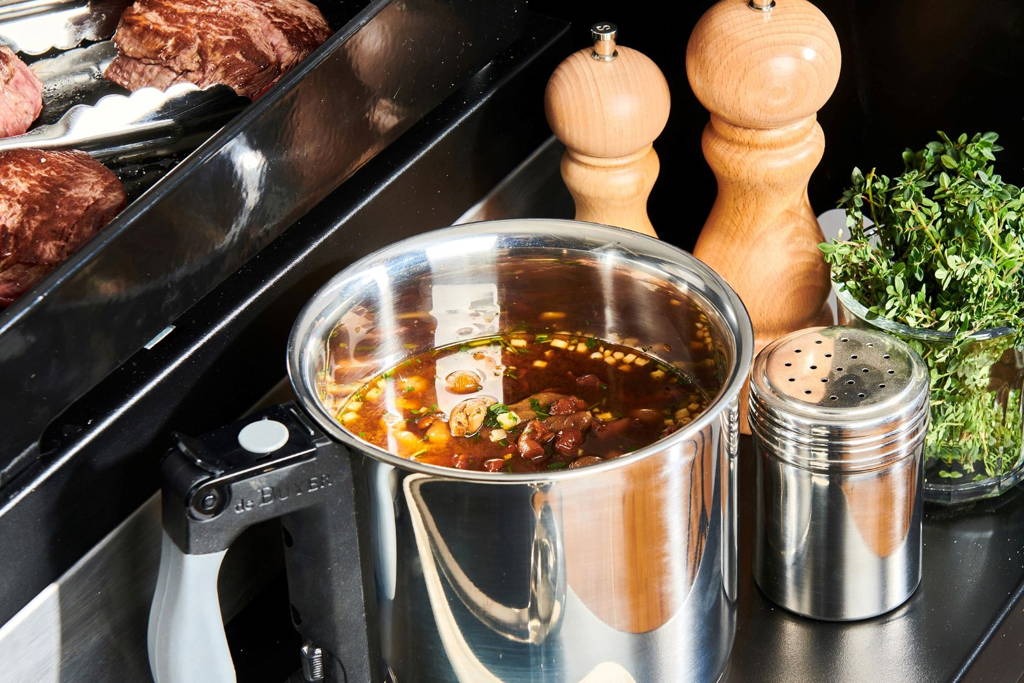An ambiguous term, the bain-marie, also referred to as a double boiler, is thrown around loosely in kitchens and recipes. With various meanings, some may find the word “bain-marie” a little confusing. So what is it? Let’s break it down.
By definition, a bain-marie is a receptacle containing hot or boiling water into which other containers are placed to warm or cook the food in them. This may seem easy enough, but within the culinary world, the term bain-marie is used in 3 main ways:
1. A traditional double boiler, which is a larger pot suited to fit a shallow amount of water with a smaller pot nestled inside such as our Double Boiler Bain-Marie.
2. A simple water bath in which something is placed to cook or bake something, for example a cheesecake.
3. Hot water or cold water and ice held in a container to help keep food warm or cold.
The purpose of using a bain-marie is to create a uniform, controlled temperature around the food. When cooking, the technique of using a bain-marie, or double boiler, typically comes into play when making delicate dishes like custards, sauces or tempering chocolate. They are extremely helpful when overheating may cause the dish to break, curdle or over cook.
The history of the bain-marie
The history of the modern day bain-marie is an interesting one. According to most sources, Mary (or Maria) the Prophetess, the ancient alchemist, is credited with inventing the bain-marie. Fun fact: it has even been named after her; in French bain-marie means “Mary’s bath”. As one of the first well-known alchemists in history, and often referred to as the mother of alchemy, Mary has left behind a legacy of inventions that are still used in chemistry labs and, well, kitchens. Mary’s original invention looked much different than our present day bain-maries or double boilers that we see in kitchens. These first versions certainly looked like lab equipment, but it’s purpose was the same – gently heating the contents of a container by surrounding it with temperature controlled water.
Most accept Mary the Prophetess at the creator of the bain-marie, however, there is known information of water baths being used for cooking centuries earlier than her time. Whether Mary turned an existing concept into something more concrete or invented it all on her own, she has brought us a kitchen tool that we cannot live without.

Bain-Maries in modern day kitchens
While the concept is similar, as mentioned above, the term “bain-marie” is loosely used in the culinary world when referring to cooking in a water bath. To give a little more context, let’s look into this further.
The most traditional form of a bain-marie is the modern day double boiler. These double boilers consist of a metal cylindrical container and a smaller metal cylindrical container that fits inside of the larger one. Water is added to the bottom of the larger container, which will begin to steam and warm the smaller container once placed onto heat. The gentle heat created by the steam is a controlled way to evenly heat the smaller container which holds and heats or cooks the food.
Although not exactly Mary’s invention, people also use the term bain-marie when describing a type of pan used to hold water to heat or cook food. In theory, the concept is the same, which is why we assume the word got easily transferred over. As an example, a springform pan used to make a cheesecake will often be placed into a larger pan with water to surround the cheesecake. This water helps to protect the cheesecake while its baking. This is not what is described above as a double boiler, but the water bath in this scenario is still called a bain-marie.
Now, to make things even more complicated, these plans can also be used to heat or cool food over a period of time. When food is out at a catering event, the idea of having one pan containing food above another with hot water or ice below it is also a bain-marie. It’s a lot, we know but most importantly, know that it works for any of these instances.
what to use a bain-marie for
You’re probably curious about why you need a bain-marie in your kitchen. You may have gotten by without one before, but bain-maries are kitchen staples and having a proper double boiler will help you perfect certain foods.
Create the silkiest sauce: The most classic would be a hollandaise sauce but any egg or dairy based sauce will thrive in a bain-marie because they are able to emulsify easier. The last thing you want is your eggs to overcook and curdle. Using a double-boiler will ensure the perfect sauce every time. Give it a try yourself with Bon Appetit’s Hollandaise and watch the magic happen.
Custards like you’ve never made before: Like sauces, custards become so much easier to perfect in a bain-marie. Making a great custard requires a lot of attention because, as we know, boiling the milk will break your custard. Constantly staring it at to ensure that it doesn’t boil can take away from the joy of cooking. A bain-marie helps with the temperature control reduces the likelihood of overcooking your dairy and from the unwanted skin to appear. Next time you find yourself needing some crème anglaise for a dessert, be sure to make it in a bain-marie, you’ll never go back.
Become an at home chocolatier: Chocolate is another one of those things that seems easy, but in reality is so easy to mess up. When melting over direct heat, chocolate can burn, clump together and loose its silkiness. When tempering chocolate in a bain-marie, the cocoa solid, fat and sugar are able to emulsify to remain smooth and shiny as it melts. This is what you want to be able to use melted chocolate in any recipe. Check out this guide by Epicurious about how to temper chocolate using a double-boiler.
You found yourself reading this for a reason. It means you’re curious about bain-maries and we think that’s great! The best way to learn about them though is to give them a try. Get your hands on our double boiler, you won’t regret it!


